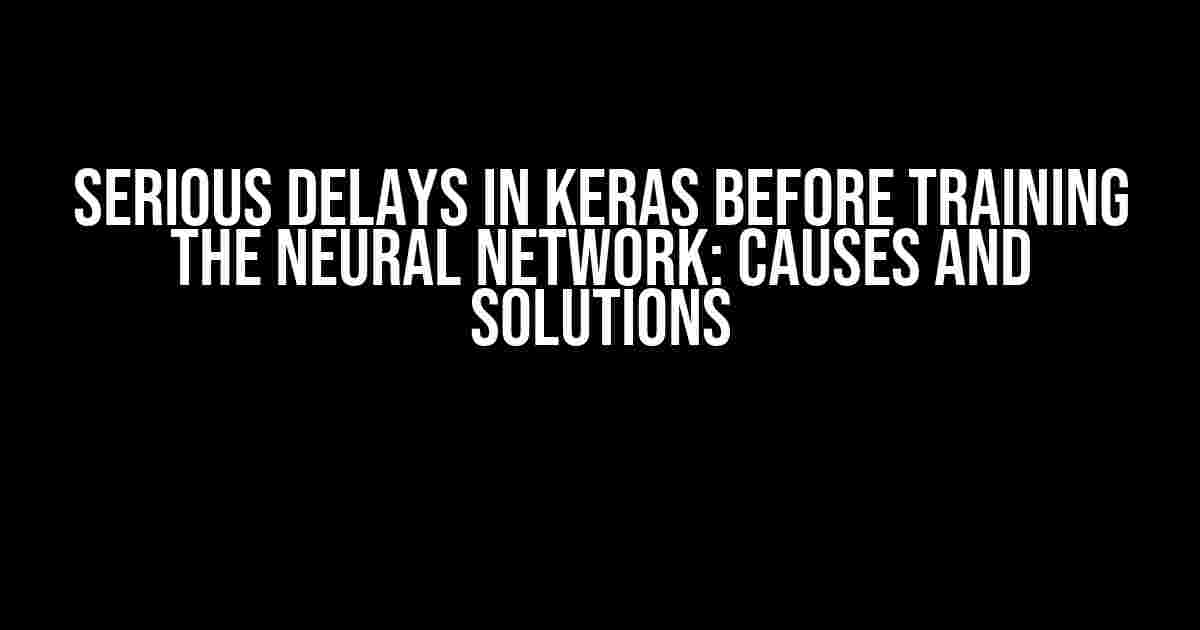Are you frustrated with the slow pace of your Keras neural network training? Do you find yourself waiting for what feels like an eternity for your model to learn from your data? You’re not alone! Many Keras users have reported experiencing serious delays before training their neural networks, and it’s not just a matter of poor coding or inadequate hardware. In this article, we’ll delve into the common causes of these delays and provide you with practical solutions to get your training process back on track.
Causes of Serious Delays in Keras
Before we dive into the solutions, it’s essential to understand the underlying causes of these delays. Here are some of the most common culprits:
-
Data Loading and Preprocessing
-
Model Complexity
-
Hardware Limitations
-
Library and Dependency Issues
-
Optimization and Compiling
One of the most significant contributors to delays in Keras is data loading and preprocessing. If your dataset is massive, it can take a considerable amount of time to load and prepare it for training. This is especially true if you’re working with large images or audio files.
The complexity of your neural network model can significantly impact training time. If your model has multiple layers, complex architectures, or a large number of parameters, it can lead to slower training times.
Insufficient hardware resources, such as RAM, GPU memory, or CPU processing power, can cause significant delays in Keras. If your machine is not equipped to handle the demands of deep learning, you’ll experience slower training times.
Outdated libraries, dependencies, or conflicts between different versions can cause delays in Keras. Keep your libraries and dependencies up-to-date to avoid these issues.
Improper optimization and compiling of your model can lead to slower training times. Make sure to choose the right optimizer and compile your model correctly to avoid delays.
Solutions to Overcome Serious Delays in Keras
Now that we’ve identified the common causes of delays in Keras, let’s explore some practical solutions to overcome them:
Data Loading and Preprocessing
Here are some tips to optimize data loading and preprocessing:
-
Use
generatororSequenceobjects to efficiently load and preprocess your data in batches. -
Implement data augmentation techniques to reduce the size of your dataset and improve training efficiency.
-
Use libraries like
tf.dataordaskto parallelize data loading and preprocessing.
from tensorflow.keras.preprocessing.image import ImageDataGenerator
# Create an image data generator
datagen = ImageDataGenerator(rescale=1./255)
# Use the generator to load and preprocess your data
train_generator = datagen.flow_from_directory(
train_dir,
target_size=(224, 224),
batch_size=32,
class_mode='categorical'
)
Model Complexity
To reduce model complexity and training time:
-
Use transfer learning and pre-trained models to leverage the knowledge gained from other datasets.
-
Implement model pruning or knowledge distillation to reduce the number of parameters.
-
Use simpler architectures, such as convolutional neural networks (CNNs) or recurrent neural networks (RNNs), instead of complex models like transformers.
from tensorflow.keras.applications import VGG16
# Load a pre-trained VGG16 model
base_model = VGG16(weights='imagenet', include_top=False, input_shape=(224, 224, 3))
# Freeze the base model layers and add new layers on top
for layer in base_model.layers:
layer.trainable = False
x = base_model.output
x = Flatten()(x)
x = Dropout(0.5)(x)
x = Dense(10, activation='softmax')(x)
model = Model(inputs=base_model.input, outputs=x)
Hardware Limitations
To overcome hardware limitations:
-
Use cloud services or virtual machines with dedicated GPU resources, such as AWS, Google Colab, or Paperspace.
-
Optimize your model to run on a specific GPU architecture, such as NVIDIA or AMD.
-
Implement model parallelism or distributed training to utilize multiple GPUs or machines.
| Hardware Configuration | Training Time (hours) |
|---|---|
| Single GPU (NVIDIA GTX 1080 Ti) | 10-15 hours |
| Multi-GPU (4x NVIDIA GTX 1080 Ti) | 2-3 hours |
| Cloud Service (AWS P3.2xlarge) | 1-2 hours |
Library and Dependency Issues
To avoid library and dependency issues:
-
Keep your Keras and TensorFlow libraries up-to-date using pip or conda.
-
Use virtual environments or containers to isolate dependencies and avoid conflicts.
-
Avoid mixing different versions of libraries, such as TensorFlow 1.x and 2.x.
pip install --upgrade keras tensorflow
Optimization and Compiling
To optimize and compile your model correctly:
-
Choose the right optimizer and learning rate schedule for your problem.
-
Use regularization techniques, such as dropout or L1/L2 regularization, to prevent overfitting.
-
Compile your model with the correct loss function, optimizer, and metrics.
from tensorflow.keras.optimizers import Adam
from tensorflow.keras.losses import SparseCategoricalCrossentropy
from tensorflow.keras.metrics import SparseCategoricalAccuracy
# Compile the model
model.compile(optimizer=Adam(lr=0.001),
loss=SparseCategoricalCrossentropy(from_logits=True),
metrics=[SparseCategoricalAccuracy()])
Conclusion
In this article, we’ve explored the common causes of serious delays in Keras before training the neural network and provided practical solutions to overcome them. By optimizing data loading and preprocessing, reducing model complexity, utilizing sufficient hardware resources, managing library and dependency issues, and optimizing and compiling your model correctly, you can significantly reduce training times and accelerate your deep learning projects.
Remember, every second counts in the world of deep learning, and by following these tips, you’ll be able to Train Faster, Learn Faster, and Achieve Faster!
Happy Training!
Here are 5 Questions and Answers about “Serious delays in Keras before training the neural network” in HTML format with a creative voice and tone:
Frequently Asked Questions
Got stuck in Keras limbo? Don’t worry, we’ve got you covered!
Why does my Keras model take forever to start training?
This could be due to the time it takes to compile the model, especially if you’re working with large datasets or complex models. Try using the `compile` method with the `verbose` argument set to 1 to get more insights into the compilation process. You can also try reducing the batch size or using a more efficient optimizer to speed things up.
Is it normal for Keras to take a long time to initialize the neural network?
Yes, it’s normal for Keras to take some time to initialize the neural network, especially if you’re working with large models or datasets. This is because Keras needs to allocate memory and perform some preliminary computations before starting the training process. However, if you notice that the initialization time is excessively long, try reducing the model complexity or using a more efficient backend like TensorFlow or Theano.
What can I do to optimize my Keras model for faster training?
There are several ways to optimize your Keras model for faster training. First, try reducing the batch size or using a more efficient optimizer like Adam or RMSProp. You can also try using a GPU instead of a CPU, or distributing the training process across multiple machines using a library like TensorFlow’s `tf.distribute` module. Finally, consider using a more efficient model architecture or pruning unnecessary layers to reduce the overall model size.
How can I troubleshoot slow performance issues in Keras?
To troubleshoot slow performance issues in Keras, try using the `profile` function to get detailed information about the time spent in each layer. You can also use tools like TensorFlow’s `tf.profiler` or the `line_profiler` library to get more insights into the performance bottlenecks. Additionally, try reducing the model complexity, using a more efficient optimizer, or optimizing your data pipeline to reduce the time spent on data loading and preprocessing.
What are some common causes of slow training times in Keras?
Some common causes of slow training times in Keras include large model sizes, complex model architectures, inefficient optimizers, and slow data loading and preprocessing. Additionally, using a CPU instead of a GPU, inadequate memory, or inefficient use of distributed computing can also lead to slow training times. Try addressing these factors to improve your model’s training speed and efficiency.


